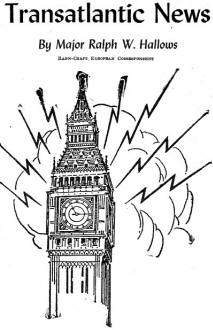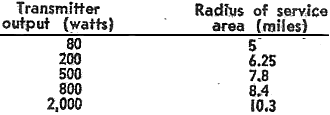|
May 1948 Radio-Craft
 [Table of Contents] [Table of Contents]
Wax nostalgic about and learn from the history of early electronics.
See articles from Radio-Craft,
published 1929 - 1953. All copyrights are hereby acknowledged.
|
Television adoption immediately
after World War II in many of the European countries lagged the United States,
probably in no small part due to a need to attend to the far more important
task of rebuilding their infrastructures and societies which were largely
decimated by Hitler and his Axis cohorts. This 1948 report in Radio-Craft
magazine told of "televisors" being mainly kits with few having displays larger
than 2 to 4 inches (smaller than most smartphone screens). 455 lines per frame
was plenty for CRTs that small (NTSC later standardized on 525 lines per frame).
Another interesting item is how even though Russia had been spared the ravages
of one form of Marxism-Nazism-Socialism-Communism from Germany, it chose to stay
is course of the same (minus, maybe, Nazism) with totalitarianism rule, to the
extent that the article's author states, "If the authorities decide that
television is good for the soul of Ivan Ivanovitch, he'll have to be keen on it,
whether he likes it or not!" The long range VHF stuff is a precursor into the
newly discovered "forward scattering" atmospheric phenomenon being researched
for over-the-horizon radar and telecommunications.
Transatlantic News
 By Major Ralph W. Hallows By Major Ralph W. Hallows
Radio-Craft, European Correspondent
Curiously television is making little appeal so far to Jacques Dubois, the French
equivalent of John Smith. There has been a regular television service in the Paris
area for some little time, and not too bad a service either. Program times are:
1150-1205 (daily, except Saturdays and Sundays); 1600-1730 (daily, except Saturdays
and every other Sunday); 2000-2130 (Tuesdays and Fridays). Times are GMT. Vision
goes out on 46 mc with a peak carrier power of 30 kw, and sound on 42 mc with 5
kw behind it. Have any of you v.h.f. dx-ers picked up the audio part? I'd be rather
surprised if you haven't, for v.h.f. is spanning enormous distances just now - a
point to which I'll return later. The vision system is 455 lines per frame and 25
frames per second, so it will not suit American standard televisers. Either 25 frames
per second or 50 frames interlaced are likely to be the standards of European countries
for the frequency of their a.c. main supply is 50 cycles per second.
I don't know of any ready-for-service French televiser on the market. Certainly
I have not seen one advertised in any French radio magazine. One sees a few kits
of parts advertised, and there's an occasional article on how to build a televiser.
But that's just about all. I believe that a few cathode-ray tubes with bigger screens
than 2 to 4 inches are produced in France. The cost of the larger ones is prohibitively
high. That may welt be the reason why there are so few viewers of the programs of
Télévision Française, the concern responsible for the present
service.
And in Russia
 The Russians are taking television very seriously.
The technical development and the program services are, of course, both official
matters there; so there can't be much doubt that television will be popular. If
the authorities decide that television is good for the soul of Ivan Ivanovitch,
he'll have to be keen on it, whether he likes it or not! An article in the Soviet
magazine Radio gives an account of the expansion contemplated between now and 1950.
In addition to the stations which have been working for some time in Leningrad and
Moscow, new transmitters of moderately high power are to come into action at Kiev
and Sverdbovsk. But that is a long way from being all. Assuming that a field-strength
of 1 millivolt per meter is required for good reception, it's calculated that the
following service areas are obtainable from small transmitters with antenna systems
50-60 meters in height. The Russians are taking television very seriously.
The technical development and the program services are, of course, both official
matters there; so there can't be much doubt that television will be popular. If
the authorities decide that television is good for the soul of Ivan Ivanovitch,
he'll have to be keen on it, whether he likes it or not! An article in the Soviet
magazine Radio gives an account of the expansion contemplated between now and 1950.
In addition to the stations which have been working for some time in Leningrad and
Moscow, new transmitters of moderately high power are to come into action at Kiev
and Sverdbovsk. But that is a long way from being all. Assuming that a field-strength
of 1 millivolt per meter is required for good reception, it's calculated that the
following service areas are obtainable from small transmitters with antenna systems
50-60 meters in height.
It must be remembered that in most parts of the U.S.S.R. there is comparatively
little man-made static to cause interference with v.h.f. transmissions.
Now, here comes a very interesting idea. It is suggested, not only that transmitters
rated up to 1,000 watts can be made from standard components by amateurs, but that
they should be made all over the country. These stations (which can use air-cooled
transmitting tubes) won't be owned or used privately. They'll be built and brought
into action, in small towns, by the cooperative effort of local fans and will then
be handed over to the municipal authorities to supply the television entertainment
of the townsfolk.
That strikes me as a magnificent idea for getting a nation-wide television service
going in the quickest possible time in a vast country which contains innumerable
small towns and villages. The big snag seems to be not the technical, but the entertainment
side. There's no provision for long-distance hookups; hence the programs must, presumably,
be of local origin. My own feeling is that I'd pay quite a bit to be spared nightly
entertainments by my local citizenry!
Long-Range V.H.F.
I often think that the writers of radio textbooks published twenty or more years
ago must feel like taking running jumps into the nearest and deepest lake when they
re-read some of the statements that they once made in cold, hard print. You'll find
it was- stated in the 1920's that frequencies above 3 megacycles were unlikely ever
to be of any great value for long-distance communications. More recent writers state
categorically that the range of transmissions on frequencies above 30 mc cannot
be much beyond the visual horizon. It has in fact, often been declared that with
v.h.f. transmissions there is no usable ground wave and no usable sky wave, the
only serviceable kind of propagation being the direct wave.
Things move so rapidly in radio today that you hardly know where you are sometimes.
If ever I write another radio book, I think I'll play for safety. In the final revision
of the proofs, besides changing every "is" into "may be" and every "know" into "believe,"
I'll insert "probably" into most of the statements.
Recent investigations in Britain have shown that v.h.f. transmissions can, and
regularly do, travel in no less than three other ways than by the direct wave! One
of these, the atmospheric duct, has been known for some time; but it was regarded
rather as a freak condition. It has nothing to do with ionization. What happens
is that, under certain conditions, a kind of wave guide is formed between a layer
of air (which may be at a height of only a few meters) and the surface of the earth.
The new discovery is that this is no freak; it is a common state of affairs in fine
settled weather, such as we had over here last summer. This accounts for the regular
reception in Europe at ranges of 130-150 miles of frequencies up to 58 mc.
But it doesn't account for transmissions of similar frequencies which span distances
up to 1,400 miles as they did for many months in 1947 when European v.h.f. transmissions
interfered badly with one 43-45 mc television service. That has been shown convincingly
to be caused by sporadic E-layer ionization, which is found to be pretty frequent
in summer time in these latitudes. Sporadic E is a superionization of the lower
reflecting layer, which occurs more often and more widely than was formerly suspected
and is influenced by sunspot activity. Appleton has shown that it can be caused
by meteoric dust. Strong sunlight can also bring it about.
And now for a quiz question for which no prize is offered. Two places, A and
B, are 1,000 miles apart. One set of radio waves from A reaches B by reflection
from the E-layer at a height of 65 miles; a second gets there by reflection from
the F-layer at a height of 200 miles. Which set meets the reflecting layer at the
larger angle?
Those that travel via the E-layer? Right! The bigger the angle the smaller is
the chance that the waves have of going smack through the layer and the greater
the chance that they will be reflected, supposing that each layer is ionized to
an equal degree. It follows that v.h.f. waves which would escape into space and
never come back to earth under ordinary conditions may be returned to earth by a
superionized E-layer. The observed critical frequencies of sporadic E are such that
the maximum range obtained in this way by v.h.f. is about 1,400 miles.
Well, there you are. Those who said that there would be no mutual interference
between v.h.f. stations working on the same frequency, so long as they were 40-50
miles apart, were somewhat off the mark. Atmospheric ducts can cause such interference
up to about 150 miles, sporadic E up to 1,400, and F-layer superionization up to
5,000 miles or more.
And those are the waves of quasi-optical range!
Posted January 2, 2020
|









 The Russians are taking television very seriously.
The technical development and the program services are, of course, both official
matters there; so there can't be much doubt that television will be popular. If
the authorities decide that television is good for the soul of Ivan Ivanovitch,
he'll have to be keen on it, whether he likes it or not! An article in the Soviet
magazine Radio gives an account of the expansion contemplated between now and 1950.
In addition to the stations which have been working for some time in Leningrad and
Moscow, new transmitters of moderately high power are to come into action at Kiev
and Sverdbovsk. But that is a long way from being all. Assuming that a field-strength
of 1 millivolt per meter is required for good reception, it's calculated that the
following service areas are obtainable from small transmitters with antenna systems
50-60 meters in height.
The Russians are taking television very seriously.
The technical development and the program services are, of course, both official
matters there; so there can't be much doubt that television will be popular. If
the authorities decide that television is good for the soul of Ivan Ivanovitch,
he'll have to be keen on it, whether he likes it or not! An article in the Soviet
magazine Radio gives an account of the expansion contemplated between now and 1950.
In addition to the stations which have been working for some time in Leningrad and
Moscow, new transmitters of moderately high power are to come into action at Kiev
and Sverdbovsk. But that is a long way from being all. Assuming that a field-strength
of 1 millivolt per meter is required for good reception, it's calculated that the
following service areas are obtainable from small transmitters with antenna systems
50-60 meters in height. 